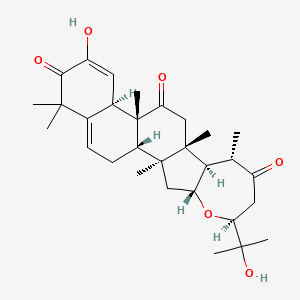| Authors | Title | Published | Journal | PubMed Link |
|---|---|---|---|---|
| Bartalis J and Halaweish FT | In vitro and QSAR studies of cucurbitacins on HepG2 and HSC-T6 liver cell lines. | 2011 | Bioorg. Med. Chem. | pmid:21459003 |
| Ramalhete C et al. | New potent P-glycoprotein modulators with the cucurbitane scaffold and their synergistic interaction with doxorubicin on resistant cancer cells. | 2009 | Bioorg. Med. Chem. | pmid:19733087 |
| Guo RH et al. | Synthesis of hemslecin A derivatives: a new class of hepatitis B virus inhibitors. | 2013 | Bioorg. Med. Chem. Lett. | pmid:23385212 |
| Chen CH et al. | Identification of cucurbitacins and assembly of a draft genome for Aquilaria agallocha. | 2014 | BMC Genomics | pmid:25005802 |
| Kuo TC et al. | The effect of red light and far-red light conditions on secondary metabolism in agarwood. | 2015 | BMC Plant Biol. | pmid:26067652 |
| Boykin C et al. | Cucurbitacin IIa: a novel class of anti-cancer drug inducing non-reversible actin aggregation and inhibiting survivin independent of JAK2/STAT3 phosphorylation. | 2011 | Br. J. Cancer | pmid:21304528 |
| Ren S et al. | Anti-proliferative effect of 23,24-dihydrocucurbitacin F on human prostate cancer cells through induction of actin aggregation and cofilin-actin rod formation. | 2012 | Cancer Chemother. Pharmacol. | pmid:22814677 |
| Jayaprakasam B et al. | Anticancer and antiinflammatory activities of cucurbitacins from Cucurbita andreana. | 2003 | Cancer Lett. | pmid:12445672 |
| GALLILY R et al. | Further studies on the antitumor effect of cucurbitacins. | 1962 | Cancer Res. | pmid:13946249 |
| Gabrielsen M et al. | Cucurbitacin covalent bonding to cysteine thiols: the filamentous-actin severing protein Cofilin1 as an exemplary target. | 2013 | Cell Commun. Signal | pmid:23945128 |
Cucurbitacin S
Cucurbitacin s is a lipid of Sterol Lipids (ST) class. The involved functions are known as establishment and maintenance of localization and nitric oxide biosynthetic process.
Cross Reference
Introduction
To understand associated biological information of Cucurbitacin S, we collected biological information of abnormalities, associated pathways, cellular/molecular locations, biological functions, related genes/proteins, lipids and common seen animal/experimental models with organized paragraphs from literatures.
What diseases are associated with Cucurbitacin S?
There are no associated biomedical information in the current reference collection.
No disease MeSH terms mapped to the current reference collection.
PubChem Associated disorders and diseases
What pathways are associated with Cucurbitacin S
There are no associated biomedical information in the current reference collection.
PubChem Biomolecular Interactions and Pathways
Link to PubChem Biomolecular Interactions and PathwaysWhat cellular locations are associated with Cucurbitacin S?
There are no associated biomedical information in the current reference collection.
What functions are associated with Cucurbitacin S?
Related references are published most in these journals:
| Function | Cross reference | Weighted score | Related literatures |
|---|
What lipids are associated with Cucurbitacin S?
There are no associated biomedical information in the current reference collection.
What genes are associated with Cucurbitacin S?
There are no associated biomedical information in the current reference collection.
What common seen animal models are associated with Cucurbitacin S?
There are no associated biomedical information in the current reference collection.
